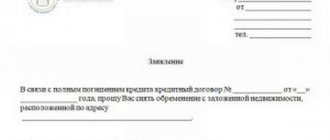Types of encumbrance
More and more often, people are now forced to sell their apartment under encumbrance.
There are many reasons for this. What does this mean – an apartment under encumbrance? One of the options for encumbrance on an apartment is people registered in the apartment in addition to the owner. Is it possible to sell such an apartment? The owner usually does not have problems when registering an apartment with an encumbrance for sale, regardless of whether anyone else is registered there or not, since no one besides the owner has the right to this property. If you have strong nerves and confidence that you are right, then buying an apartment under encumbrance is a good option to save money. But before making such a transaction, you need to know all the details, otherwise it may burden you with big problems later. When making a transaction with such an apartment, you need to carefully study the contract. Today in Russia, due to limited funds and difficult financial situations, many are forced to take out loans - for the purchase of small goods, for the purchase of cars and housing. A mortgage is one of the options for collateral in which the mortgaged property is owned by the debtor, and the lender acquires the right to receive satisfaction from the sale of this property in the event of the borrower’s failure to fulfill its obligations.
In the case of mortgage lending, the loan is issued against real estate. When taking a loan to purchase real estate, the purchased property itself is pledged by the bank as a guarantee of loan repayment (an encumbrance is placed on the property).
Who has the right to impose a burden? These are territorial bodies of the Office of the Federal State Registration Service (Rosreestr).
Deal Features
must be subject to state registration. This is justified by the fact that the information is entered into the Unified State Register of Rights and when concluding transactions with real estate, an extract from the Unified State Register contains information about the absence or presence of encumbrances. This allows you to protect potential buyers from those sellers who want to conceal information about any encumbrance. Anyone can find out whether a particular apartment is under encumbrance. the borrower must repay the loan in full with all interest and penalties specified in the agreement. The mortgagor contacts the bank with a request to submit an application to the state registration department to remove the encumbrance from the housing purchased with a mortgage. In case of full repayment of the mortgage, the registration record of the encumbrance becomes canceled. A stamp is affixed to the certificate of registration of ownership, proving. If the borrower does not fulfill the loan obligations in full, then he is deprived of the right to dispose of his residential property without the bank’s consent; in this case, the apartment is sold to compensate the bank for costs. But in most cases, the bank and the borrower do not bring the matter to court and resolve the issue peacefully. Example: sale of encumbered real estate with payment of loan debts subsequently.
Usually banks give their consent to the sale of apartments by the owners themselves. After all, the bank is not interested in the apartment; it is important for it to return the money owed on the loan. Having received the bank's consent, the owner needs to find a buyer. When a buyer is found, the bank where the apartment was pledged formalizes the deal. After this, the mortgage encumbrance is removed from the property. The procedure for the purchase and sale of apartments pledged by the bank has already been worked out and differs from a transaction with ordinary housing:
- the buyer of real estate rents two cells - for the bank and for the seller;
- the buyer places funds in the bank safe deposit box to repay the loan;
- if some amount remains, it goes to the apartment seller’s cell;
- after receiving the required amount, the bank issues a certificate stating that the loan has been repaid;
- subsequently, a purchase and sale agreement is concluded between the new owner and the seller, and subsequently it is registered in Rosreestr;
- after registering the contract, the new owner is issued an extract stating that the encumbrance on the apartment has been lifted;
- upon completion of all transactions, the seller can withdraw the amount due to him from the cell, and the buyer receives ownership.
Apartments under encumbrance are very popular on the market, since they are usually in good condition, do not require large investments, are legally clean, and the price of such apartments is significantly lower than the market price.
How can I find out about encumbrances?
Naturally, when purchasing real estate, you need to carefully check all the information about the property you are purchasing, otherwise there is a risk of getting into a lot of problems.
There are two options by which you can establish the presence of encumbrances:
- Enlist the help of a special agency that deals with real estate transactions. This method is beneficial for the buyer in that the inspection will be carried out by a professional who has sufficient experience and knows all the inspection algorithms. However, there is still a certain amount of risk, for example, a large number of unscrupulous or simply inexperienced specialists have appeared on the market.
- Carrying out an independent check can also give the correct result. To do this, you will need to obtain an extract from the Unified State Register. You can even order such a document via the Internet.
The certificate will contain the following information:
- All property owners. This will help establish whether the seller actually has title to the property.
- Technical data of the object.
- The presence of any restrictions or encumbrances.
Possible difficulties
But still, when buying apartments with encumbrances, you can encounter great difficulties.
For example: before concluding a purchase and sale agreement, the buyer deposits money intended for the purchase of a home in a safe deposit box, the bank checks it and allows the encumbrance to be removed. And when the apartment is already released from collateral, the seller refuses the deal. The buyer will need to force the previous owner through the court to complete the transaction or refund the money paid. To avoid such a case, it is necessary to draw up a preliminary deposit agreement. Another example: the apartment is sold and debt obligations to the bank are fulfilled, but the former owner does not move out. In this case, it is necessary to apply to the court with a demand to recognize the former owner as having lost the right to use and eviction. Consideration of such claims may take a long time.
Auctions for the sale of pledged property are organized by the bodies that carry out the execution of court decisions, and they are held at the location of the property. The organizer of the auction informs about its holding no later than 10 days and no earlier than 30 days before the day of the auction. Persons wishing to participate in public auctions must make a deposit (no more than 5% of the initial value of the pledged property). The winner of the public auction is the person who offered the highest price. Within five days from the date of payment of the purchase price, a real estate purchase and sale agreement is concluded. This agreement, as well as the protocol on the results of the auction, are the basis for registering the relevant entries in the Unified State Register of Rights to Real Estate and Transactions with It. Conducting an auction is different from public bidding. The initial price of the collateral is determined based on an expert assessment. Information about the auction is published in a periodical (the official resource of the executive branch) from 6 to 13 days before the date of the auction. Those wishing to participate in the auction also make a deposit not exceeding 5% of the starting price.
The winner is the person who offered the highest price. The winner and the auction organizer sign a protocol on the results of the auction. Once the full amount has been paid, a purchase and sale agreement is concluded and ownership is registered.
Call the number and our lawyer will answer all your questions for FREE
Encumbrance means restricting the use, possession and disposal of property. However, not every limitation is one. The main feature is that it is imposed in accordance with the law.
Comes in two forms:
- at the will of the owner, voluntary;
- against the will of the owner, forced.
An example of a voluntary encumbrance is a pledge: the owner pledges what he owns, thereby encumbering it. Compulsory encumbrance - arrest. When property is seized by court order, the owner’s opinion is no longer asked.
Encumbrance means a restriction on actions regarding any disposal of property. That is why, in order to avoid problems, when purchasing real estate it is necessary to find out exactly whether it is not encumbered.
When passing from one hand to another, the nature and duration of the encumbrance does not change. Thus, when purchasing or inheriting a property, the buyer assumes all associated encumbrances.
Types of encumbrances
- Mortgage: The owner pledges the property to secure the debt;
- Seizure: property is seized for debts;
- Trust management: the property is managed not by the owner himself, but by his trustee, legal representative (for example, in case of incapacity of the owner);
- Restrictions on the disposal of property for the needs of government bodies;
- Any other actions, transactions and restrictions that are burdensome.
Reasons for the restriction:
- laws of the Russian Federation. For reasons specified in laws, property may be subject to encumbrance;
- the court's decision;
- agreement, transaction, the result of which is an encumbrance;
- an act issued by government agencies.
Right to use real estate
Certain types of real estate rights may result in encumbrances:
- Rent. When a real estate lease agreement is concluded, certain obligations are imposed on the lessor. Upon subsequent sale of this property, the lease agreement will not be terminated. In this case, all obligations on the property are transferred to the new owner along with it;
- The right to use property free of charge is exercised according to the same principle. The sale of an object encumbered by this right does not imply termination of the contract. This means the transfer of the encumbrance to the new owner; as a type of annuity - lifelong maintenance with dependents. The basis for such content is the concluded agreement;
- Easement. There is a partial encumbrance on the land. The essence of an easement is that the owner of a plot of land has the right to partially use the neighboring plot. We are talking about laying paths, passages, etc. This is appropriate when it is impossible to get to an important object (for example, a water source) bypassing the neighboring site.
Features of selling an apartment with encumbrances
As a rule, we are talking about mortgaged apartments. It is worth noting that in this situation the bank is absolutely not interested in real estate, only the return of money is important.
The procedure itself has the following differences from the standard one:
- It is necessary to rent two separate cells for the seller and for the bank
- Funds are deposited into a safe deposit box intended for the bank, after which a document is issued confirming the fact of repayment of the loan
- The concluded agreement between the seller and the buyer is concluded without the participation of the bank; its registration is carried out in Rosreestr
- The new owner receives documents confirming the fact that the encumbrance has been lifted.
Rent
The essence of a lease is the transfer of a land plot or real estate property for temporary use. Any object can be rented, except those withdrawn from general circulation.
The lease agreement is concluded in writing and must be signed by both parties. In case of any failure to comply with the form and procedure for concluding the contract, it will be declared invalid. When a plot, real estate or part thereof is rented out, a cadastral plan is attached, highlighting the part that is rented out.
Encumbrance of a share of property
The restriction may affect not only the property as a whole, but also its share. This occurs when the owner only has a share of the property.
It is fair to note that encumbering the entire property, for example, in the form of an arrest, deprives the owner of the right to sell it. But if a share is encumbered, then the owners of other shares have the right to sell them, etc. The only significant limitation on their actions is the division of property according to shares.
Thus, encumbrance involves restricting actions to dispose of property. There are many types of encumbrances that affect the rights of the owner in different ways. In addition, the encumbrance is most often temporary in nature and exists until the end of the contract or the completion of any actions.
Encumbrances on property rights are restrictions that arise on the basis of law or contract and limit the ability to own, use or dispose of this property. Some encumbrances arise at the will of the owner (for example, a pledge of his property), others do not depend on him (for example, an arrest). The presence of encumbrances to one degree or another limits the freedom to perform various actions with property (conclusion of transactions, use). Before concluding a transaction, a potential buyer must receive complete information about the existing encumbrances of the property.
Encumbrances are usually inextricably linked with the property and most often survive the transfer of rights to the property to another person. The one who acquires property acquires it along with the corresponding encumbrances, even if nothing is specified in this regard in the transaction.
Encumbrances on real estate are subject to state registration, therefore they are separately highlighted in the law.
What are the encumbrances?
The list of encumbrances is listed in Article 5 of the Law of the Republic of Kazakhstan “On state registration of rights to real estate and transactions with it.” Real estate encumbrances subject to registration include:
- right of use for a period of at least 1 year, including rent, gratuitous use, easements, right of lifelong maintenance with dependents;
- the right of trust management, including in guardianship, trusteeship, inheritance legal relations, bankruptcy and others;
- pledge;
- arrest;
- restrictions (prohibitions) on the use and disposal of real estate or on the performance of certain works imposed by government bodies within their competence;
- other encumbrances of rights to real estate provided for by law.
Similar encumbrances may arise in relation to any other property (movable: cars, money, shares and participation interests, intellectual property).
Right of use
The right to use property encumbers this property. These rights include:
- Rental right. The presence of a tenant does not prevent the conclusion of a transaction with the property (for example, its sale). But in accordance with Article 559 of the Civil Code of the Republic of Kazakhstan (Special Part), the transfer of ownership of leased property to another person is not grounds for changing or terminating the lease agreement. That is, all obligations under the lease agreement concluded by the previous owner will be transferred to the new owner of the property for the entire duration of this agreement.
- Right of free use (loan agreement). By analogy with a lease, the rights of the new owner are encumbered by the rights of a gratuitous user of the property (borrower) for the entire duration of the agreement (Article 614 of the Civil Code). In this case, the consent of the borrower to change the owner is not required.
- An easement is the right to limited targeted use of someone else’s land plot, including for passage, travel, laying and operating necessary communications, hunting and other needs. The easement is preserved in the event of transfer of ownership of a land plot or land use rights to another person (Article 73 of the Land Code of the Republic of Kazakhstan). Obtaining anyone's consent to alienate a plot encumbered by an easement is not required.
- The right to lifelong maintenance with dependency is a type of annuity that arises on the basis of an agreement when the recipient of the annuity transfers the real estate belonging to him into the ownership of the annuity payer, and the latter undertakes to provide lifelong maintenance with the dependency of this citizen or a third party specified by him. In accordance with Article 538 of the Civil Code, the prior consent of the annuitant is required for the alienation, collateral or other encumbrance of property.
The right to use real estate is subject to mandatory registration for a period of at least one year. Without registration, these rights are not considered to have arisen.
The rights to use real estate for a period of less than a year, as well as the rights to use other property for any period, are also encumbrances, but are not subject to registration, unless otherwise provided by law for certain types of property.
Right of trust management
Trust management is a transaction under which the trustee manages, on his own behalf, the property transferred to the owner for his possession, use and disposal. In accordance with Article 891 of the Civil Code, the transfer of ownership of entrusted property does not terminate the entrusted management of the property. The trustee's consent to change ownership is not required.
Pledge
A pledge is an encumbrance that arises when concluding a pledge agreement and ensures the fulfillment of the main obligation (for example, borrowing money). By virtue of a pledge, the pledgee can repay the debt from the value of the pledged property primarily to other creditors of the pledgor. In the event of a transfer of ownership of the pledged property from the pledgor to another person, the right of pledge remains in force. The legal successor of the pledgor takes the place of the pledgor and bears all the obligations of the pledgor (Article 323 of the Civil Code of the Republic of Kazakhstan (General Part)). Transfer of ownership under a transaction is possible only with the consent of the pledgee.
Arrest
Seizure of property is a ban on any transactions with property, imposed by a court, a bailiff, or an agency of inquiry or preliminary investigation. No transactions can be made with the seized property until the seizure is lifted. The owner of the seized property, to whom it was handed over for storage, is obliged to ensure its safety.
Restrictions imposed by government authorities
An example of such restrictions may be a restriction on the disposal of a taxpayer’s property in cases of non-payment of tax debt (Article 613 of the Tax Code of the Republic of Kazakhstan). The taxpayer is obliged to ensure the safety of limited-disposal property and is not entitled to enter into transactions with it.
Encumbrance on a share in property
In some cases, the owner owns a share in certain property and this share may be under an encumbrance (mortgage, arrest, etc.)
When an encumbrance (seizure) is placed on a share in the ownership of property, there is no possibility of alienation of the entire property by agreement between the co-owners. At the same time, an arrest, pledge or other encumbrance on a share in the property does not prevent other participants in the common property from disposing of their shares at their own discretion (sell, donate). An encumbrance on a share deprives the participants of the common property of the right to divide the property in kind by agreement between them, since such a division actually carries out actions in relation to the share of the property on which the encumbrance is imposed.
How can I find out about existing restrictions?
Restrictions on real estate
All restrictions on real estate must be registered with the justice authority at the location of this property. You can find out about their availability from a certificate of registered rights issued by the justice authority through the Public Service Center (PSC). This certificate will contain a list of restrictions as of the date of its receipt, indicating the types of restrictions, acts or transactions on the basis of which the restrictions were imposed, as well as the copyright holders or bodies that imposed the restrictions.
An application for a certificate of registered rights will be accepted from any person who presents an identification document and provides the address of the property.
Transport restrictions
The traffic police authorities at the place of registration of the vehicle register all received encumbrances on them. Verification of encumbrances is carried out upon deregistration and registration. Only the owner or his representative by proxy can obtain information about the presence of encumbrances.
Restrictions on other property
For most types of property other than real estate and transport, there is no special procedure for registering rights and encumbrances. When restrictions arise, such property is often confiscated from the owner (seized property is transferred for storage to another person, a pledged item is transferred to the pledgee) or sealed. There is no way to reliably verify the absence of encumbrances.
Encumbrance is a restriction that arises on the basis of an agreement or law and limits the ability to own, dispose or use property. Some restrictions may arise at the will of the owner (for example, a pledge of property), others do not depend on him (for example, arrest). Thus, the definition of encumbrance is a restriction on the use of property.
The encumbrance restricts the freedom to perform any actions with real estate (use, conclusion of transactions). Before concluding a transaction, a potential buyer must obtain complete information about the encumbrances on the property. The encumbrance is always inextricably linked with the property and usually survives its transfer to another owner. Anyone who buys something buys it along with all its encumbrances, even if nothing was specified in the transaction.
Types of encumbrance of rights to real estate
There is a clear classification in the legislation. Naturally, depending on the type of restriction, there will be specific legal features. Let us consider in more detail the various types of encumbrances.
Rent
An encumbrance in the form of a lease implies the following:
- The premises were transferred for use to third parties on the basis of a lease agreement. It must stipulate clear conditions for the operation of the property and the agreed terms and rent.
- The matter is complicated by the fact that if the contract term exceeds twelve months, it was subject to mandatory registration with the authorized state body.
- Often, a tenant of premises can extract additional benefits from real estate by subletting space.
- Violation of the terms of an already concluded agreement is not allowed even if the owner of the premises has changed. Therefore, when purchasing premises that have already been leased, it is worth carefully studying the terms of the agreement under which it was transferred for operation to third parties.
Mortgage
You can come across a mortgaged apartment on the real estate market quite often, because given the current cost of real estate, lending is quite widespread.
What nuances accompany real estate with this encumbrance:
- When purchasing such an apartment, it is mandatory to draw up an agreement according to which the buyer pays the remaining portion of the mortgage. It is noteworthy that such an agreement must be formalized by a notary.
- The purchase and sale agreement is concluded only after the debt to the bank is repaid.
- In order to avoid a difficult situation and various kinds of misunderstandings, all facts of transfer of funds must be confirmed by receipts.
- In the event that you plan to carry out a real estate transaction on which a mortgage has been concluded, you will definitely need to obtain the appropriate permission from the bank.
Easements
From a legal point of view, this term means a restriction under which a land plot is given by the owner for use to a third party.
Let's note some features:
- This type of encumbrance most often arises as a result of the laying of any communications on the land plot.
- This method is used as a last resort, as practice shows, when laying utility networks, they try to avoid entering private territory through engineering solutions.
- In fact, this encumbrance is quite unpleasant and can cause the owners of the site a very significant number of problems.
Rent
What can be seen in the legislation regarding this situation? Let's look at the features of the annuity in more detail:
- In the event that a citizen acquires real estate on which there is a rent agreement as an encumbrance. Then all rent obligations naturally fall on the new owner. In this case, all points must be complied with without fail.
- Rent is a very serious type of encumbrance; it is worth once again weighing all the pros and cons when purchasing such objects.
Pledge
Collateral property is also often found on the market; as a rule, it is required to conclude an agreement when borrowing funds.
In this case, the borrower can be:
- Bank
- Legal entity, for example, micro credit organization
- Any private person
Let's celebrate! A transaction with such real estate is permitted only with the permission of the borrower. However, this permission can only be obtained in writing and with notarization.
Property seizure
A slightly less common encumbrance, but nevertheless it also deserves special attention:
- With such an encumbrance on the property, a ban is imposed on carrying out any actions with the property.
- Such a ban is imposed by a bailiff, court or other authorized body.
- It will be possible to sell such property only after the seizure of the property is lifted.
- The owner is required by law to keep the property under arrest in proper condition and in complete safety.
Encumbrances and their types
Types of encumbrances existing in the legislation:
- the right to use real estate for a period of at least a year, including easements, gratuitous use, rent, lifelong maintenance;
- trust management (in case of guardianship, trusteeship, bankruptcy, inheritance, etc.);
- arrest;
- pledge;
- restrictions on the disposal and use of real estate or on the performance of any specific work. These restrictions may be imposed by government agencies within their competence;
- other transactions that may encumber real estate, provided for by current legislation.
A restriction may arise based on:
- acts of government agencies (local authorities);
- transactions carried out in relation to real estate;
- law;
- a court decision that has entered into legal force.
What is the procedure for seizing real estate
The arrest procedure is as follows:
- The bailiff in this case makes requests to financial institutions about the availability of accounts issued in the name of the debtor, including bank cards.
- If the bailiff discovers that the debtor does not have the funds necessary to repay the debt, then the next point of inspection is property and real estate.
- If the amount of debt is too large, it is quite possible that the apartment will be seized. If a citizen only owns a share in an apartment, then only part of it will be seized.
Right to use real estate
The right to use real estate encumbers it. Below are listed and described the rights that may encumber real estate.
- Rental right. If at the time of conclusion of the transaction the property is rented, this does not in any way affect the conclusion of the transaction (for example, the sale of property). Moreover, in accordance with the law, the transfer of ownership of property leased to another person is not grounds for termination or modification of a previously concluded agreement. That is, the new owner of the property will receive all obligations under the lease agreement concluded by the previous owner for the entire duration of this agreement.
- The right to free use (loan). Similarly, with a lease, the rights of the new owner are necessarily encumbered by the rights of the borrower (gratuitous user of the property) for the entire period. The consent of the borrower is not required to change the owner of the property.
- Lifetime maintenance with dependency is one of the types of annuity based on a contract, in which the recipient of the annuity transfers his property into the ownership of the one who pays the rent, in turn, the latter undertakes to provide lifelong maintenance with the dependent of this citizen or a third party. For pledging, alienation or other encumbrance, the consent of the annuity recipient is required.
- An easement is the right to limited use of someone else’s plot of land in accordance with the law. An easement is established to ensure travel and passage through a neighboring plot, operation and installation of power lines, pipelines and communications, provision of land reclamation and water supply, and also if any other human needs cannot be provided without its establishment. That is, the owner of the property (land plot or other real estate) has the right from the owner of the neighboring plot to demand the right to use the neighboring plot. An easement encumbers structures, buildings and other property, the use of which is vitally necessary regardless of the use of the land.
State registration of such agreements was canceled in order to avoid duplicating all registration actions.
In addition, this led to additional financial costs for both ordinary citizens and organizations. Persons who applied for registration actions paid the state fee (1,000 rubles for citizens and 15,000 rubles for organizations) twice – both for the registration of the contract itself and for the registration of the encumbrance.
Receiving the information
Established encumbrances in any form impose some difficulties on the disposal of the land plot. This is very important to know for the future owner who wants to purchase it for himself, for his own purposes. But the restriction is not always indicated in the sales documents, and this can only be found out after a certain time, which should be checked.
The first authority where you should contact to obtain detailed information about the site is the Russian Register. Here you will need to order an extract, which will display complete information about the established restrictions and their types. Check all the data in it, as well as information about the land plot. In any case, even if there are no encumbrances on the plot, you will need it to supplement the documents on registration of the transaction. This extract is provided to everyone who needs it. The restriction will be fully described with details.
If you don’t have the time and energy to cope with this task on your own, to find out all the information about the land plot, to check whether there are any restrictions, then it is best to contact qualified specialists who will do the entire amount of work for you, collecting detailed information. Based on this, you can think about whether it is worth collaborating with such an owner.
The encumbrance of land plots imposes certain restrictions on its disposal. This is very important when using the site, as well as in the event of concluding a transaction with a third party. The difficulties that arise associated with this process are best resolved by the owner himself in order to remove all harassment and the established restrictions, so that in the future it will be a simple option, for example, selling it.
Save
Trust management
The owner can transfer the property to a trust. Such a transfer of property does not entail the transfer of ownership rights to a trustee, who is obliged to carry out management in the interests of the copyright holder or the person specified by him. Rights to real estate, which are associated with its disposal on trust, are registered only on the basis of documents, which in turn determine the relationship between the owner and the manager, including on the basis of a court decision or agreement. An onerous agreement for trust management of real estate is concluded in writing as an onerous document. Trust management and transfer of real estate are subject to state registration in the same manner as the transfer of the right to ownership of property. Failure to comply with the forms of the agreement drawn up for trust management makes it invalid.
Rental limitation
Under the lease agreement, the lessor undertakes to give it to the tenant for temporary use. Land plots, except those that have been withdrawn from circulation, are leased in accordance with the Land Code and civil legislation of the Russian Federation.
An onerous contract must be in writing and signed by both parties to the transaction. Failure to comply with the form of the contract makes it invalid. It is worth noting that one of the parties can apply for registration (that is, for example, a tenant’s application is quite sufficient). When renting out a land plot or part of it, a cadastral plan of the entire plot indicating the part that was handed over is attached to the encumbrance agreement. When renting out a structure, building or part of the premises, the contract must be accompanied by a floor plan of the building, structure, on which the territory being leased is indicated, indicating its entire area.
Restriction in the form of collateral
A pledge is an encumbrance that arises when concluding a pledge agreement and ensures the fulfillment of the main obligation (for example, a loan of funds). By virtue of a pledge, the pledgee can repay the debt from the value of the property that was pledged, primarily to the creditors of the pledgor. If the ownership of previously pledged property has passed from the mortgagor to some other person, the right of pledge in any case remains in force. It should be noted that this encumbrance allows for the transfer of ownership only with the consent of the mortgagee.
Features of restrictions
When imposing encumbrances, it is impossible to do without the norms of the Land Code. It is on its basis that all rights and obligations regarding disposal and ownership are established. And here, almost every chapter or section reflects certain types of encumbrances. It is worth noting that the established truncations of rights must necessarily apply not only to owners and possessors, but also to all those who in any way use the land plot.
Encumbrances in any form must undergo registration with government agencies. If any changes occur in the legal title of a piece of land, they still cannot affect the designated encumbrances. These should be taken into account when purchasing a plot as everything will be handed over to you and they will need to be adhered to. Before making a transaction with the owner of the plot, it is important to check the legal “purity”, and then sign the papers. Otherwise, you may encounter certain difficulties and problems when registering ownership of a plot of land.
To remove the established restriction, the owner must personally contact the appropriate government authorities, depending on the type. In addition to the application, you will also need to attach a list of documents. So, in order to remove the encumbrance associated with the mortgage, it is important to pay the entire required amount and obtain a document from the bank confirming the fact of payment.










